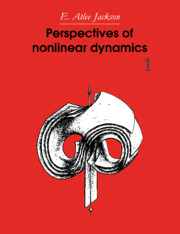
-
Select format
-
- Publisher:
- Cambridge University Press
- Publication date:
- January 2010
- September 1989
- ISBN:
- 9780511623974
- 9780521426329
- Dimensions:
- Weight & Pages:
- Dimensions:
- (247 x 174 mm)
- Weight & Pages:
- 0.92kg, 520 Pages
You may already have access via personal or institutional login
Book description
The dynamics of physical, chemical, biological, or fluid systems generally must be described by nonlinear models, whose detailed mathematical solutions are not obtainable. To understand some aspects of such dynamics, various complementary methods and viewpoints are of crucial importance. In this book the perspectives generated by analytical, topological and computational methods, and interplays between them, are developed in a variety of contexts. This book is a comprehensive introduction to this field, suited to a broad readership, and reflecting a wide range of applications. Some of the concepts considered are: topological equivalence; embeddings; dimensions and fractals; Poincaré maps and map-dynamics; empirical computational sciences vis-á-vis mathematics; Ulam's synergetics; Turing's instability and dissipative structures; chaos; dynamic entropies; Lorenz and Rossler models; predator-prey and replicator models; FPU and KAM phenomena; solitons and nonsolitons; coupled maps and pattern dynamics; cellular automata.
Contents
Metrics
Altmetric attention score
Full text views
Full text views help Loading metrics...
Loading metrics...
* Views captured on Cambridge Core between #date#. This data will be updated every 24 hours.
Usage data cannot currently be displayed.
Accessibility standard: Unknown
Why this information is here
This section outlines the accessibility features of this content - including support for screen readers, full keyboard navigation and high-contrast display options. This may not be relevant for you.
Accessibility Information
Accessibility compliance for the PDF of this book is currently unknown and may be updated in the future.


